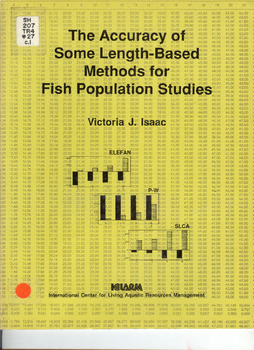The accuracy of some length-based methods for fish population studies

Citation
Isaac, V.J. (1990). The accuracy of some length-based methods for fish population studies. ICLARM Tech. Rep. (27): 81 p.
Monte-Carlo simulations of fish populations with different biological characteristics were generated to test the accuracy of some recent methods for the assessment of growth in fishes on the basis of length data. Threemethods were investigated: D. Pauly and N. David's Electronic Length-Frequency Analysis (ELEFAN), J.G. Shepherd's Length Composition Analysis (SLCA) and the method derived by J.V.-Wetherall from the general model of D.G. Powell referred to as the "P-W method". The effects of different growth strategies; variability of growth between individual fishes; seasonal oscillations of growth rates; size-dependent gear selection; recruitment variability; variable width of the length classes in the data; and combination of size-at-age and length-frequency data of fish populations were analyzed. The simulated populations were sampled at random, and the resulting length-frequency distributions were used to estimate the parameters L sub( infinity ) and K of the von Bertalanffy growth equation. A sensitivity analysis of the length-converted catch curves, used for estimation of total mortality rate (Z) was performed, and the implications of the input of biased growth parameters for the derivation of mortality rates are discussed.
Permalink
Date Available
Type
Publisher
Copyright
CC BY 4.0
Research Themes
Topics
Language